
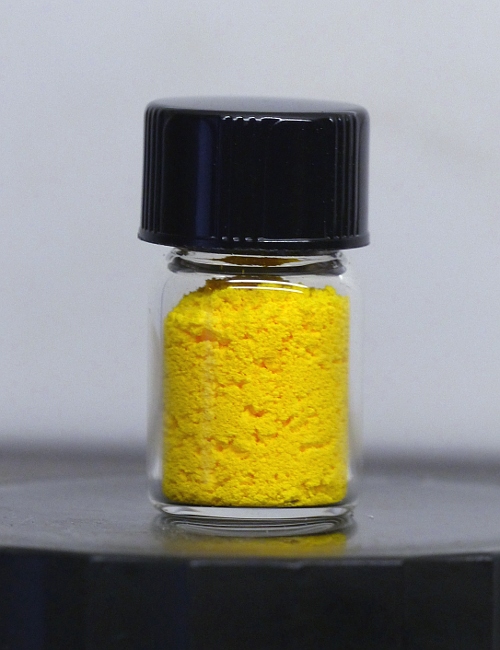

A remarkable insoluble
polyhalide salt
Polyhalide ions are quite unstable and easily lose free halogen, or a mixed halogen compound and a simple halide ion remains behind. In aqueous solution, such ions also are quite unstable and tend to lose free halogen or hydrolyse, giving rise to formation of oxoacids and free halogen. These ions, however, can be stabilized in combination with large cations in a solid salt. An experiment with the rubidium salt of tetrachloroiodate(III) demonstrates the stabilizing effect of the large rubidium ions. The solid is fairly stable and only slowly releases iodine trichloride. When the solid is added to water, then, however, it quickly decomposes, giving hydrochloric acid, iodine and iodic acid.
In this experiment, an even more stable salt of the tetrachoroiodate(III) ion is made, using the large cation N(CH3)4+. With this cation, a nearly insoluble salt is formed, which even can be kept in plain water for multiple days without decomposition.
![]()
![]() Required chemicals:
Required chemicals:
- tetramethylammonium chloride, N(CH3)4 Cl
- iodic acid
- concentrated
hydrochloric acid (at least 30% HCl)
- sodium sulfite
- sodium hydroxide
- ammonia (5% NH3
is suitable)
![]() Required equipment:
Required equipment:
- test tubes
-
little beaker or erlenmeyer
![]() Safety:
Safety:
- Concentrated hydrochloric acid is corrosive. Avoid contact with skin. If by accident some of the acid comes in contact with skin, then quickly rinse the skin with plenty of water.
- Iodic acid is a strong oxidizer.
- Sodium hydroxide is very corrosive. Avoid contact with skin. If some of this comes in contact with skin, then rinse with water, until the slippery feeling has gone.
- In this experiment, chlorine gas is produced. Do this experiment outside, or use very good ventilation. Avoid inhalation of chlorine gas.
- Ammonia is irritating and fairly
corrosive to skin.
![]() Disposal:
Disposal:
- All solid waste can simply be destroyed by dissolving in a solution of sodium sulfite or sodium hydroxide. The resulting solution can be flushed down the drain with a lot of water.
![]()
Demonstration of insolubility
of tetramethylammonium tetrachloroiodate(III)
A very simple experiment
demonstrates the low solubility of tetramethylammonium
tetrachloroiodate(III) in aqueous solution.
![]() Add
some solid iodic acid to concentrated hydrochloric acid. When this is
done, then chlorine gas is produced vigorously and the liquid turns
golden yellow. A piece of iodic acid at the size of an average pea
dissolves in 5 ml of concentrated hydrochloric acid within a few
minutes.
Add
some solid iodic acid to concentrated hydrochloric acid. When this is
done, then chlorine gas is produced vigorously and the liquid turns
golden yellow. A piece of iodic acid at the size of an average pea
dissolves in 5 ml of concentrated hydrochloric acid within a few
minutes.
![]() In
a separate test tube, dissolve a small amount of tetramethylammonium
chloride in a few ml of concentrated hydrochloric acid. The solid
quickly dissolves in the acid. To this solution, add a piece of iodic
acid. The piece of iodic acid is covered with a bright yellow layer and
then the reaction stops. Only a few small bubbles of chlorine gas are
produced. When the liquid with the piece of iodic acid is shaken, then
small pieces of yellow solid material split off and exposed iodic acid
immediately is covered with the yellow solid. Even after two days of
storage, still most of the iodic acid remains undissolved and a yellow
precipitate is formed under a colorless liquid.
In
a separate test tube, dissolve a small amount of tetramethylammonium
chloride in a few ml of concentrated hydrochloric acid. The solid
quickly dissolves in the acid. To this solution, add a piece of iodic
acid. The piece of iodic acid is covered with a bright yellow layer and
then the reaction stops. Only a few small bubbles of chlorine gas are
produced. When the liquid with the piece of iodic acid is shaken, then
small pieces of yellow solid material split off and exposed iodic acid
immediately is covered with the yellow solid. Even after two days of
storage, still most of the iodic acid remains undissolved and a yellow
precipitate is formed under a colorless liquid.
![]()
Production and isolation of solid tetramethylammonium tetrachloroiodate(III)
The above simple experiment demonstrates that making tetramethylammonium tetrachloroiodate(III) must be done in a different way. First, iodic acid must be dissolved in hydrochloric acid. This gives tetrachloroiodate(III) in solution as follows:
HIO3 + 5H+
+ 6Cl–→ICl4– + 3H2O + Cl2
The ICl4– remains in solution as golden yellow ions. These ions form a precipitate with tetramethylammonium ions, which are added after the iodic acid has dissolved.
The procedure for making solid tetramethylammonium tetrachloroiodate(III) is as
follows:
![]() Dissolve some iodic acid in hydrochloric acid. Take a pea-sized piece
of iodic acid and add this to 5 ml or so of concentred hydrochloric
acid. If at the end of the reaction, the iodic acid dissolves slowly,
then add a ml or so of concentrated hydrochloric acid and if necessary,
heat gently. Do not overheat,
as that will decompose the tetrachloroiodate ion! At the end of the
reaction this solution is golden yellow/orange. Be careful with this
reaction. Quite some chlorine gas is produced. Avoid inhaling this gas.
Dissolve some iodic acid in hydrochloric acid. Take a pea-sized piece
of iodic acid and add this to 5 ml or so of concentred hydrochloric
acid. If at the end of the reaction, the iodic acid dissolves slowly,
then add a ml or so of concentrated hydrochloric acid and if necessary,
heat gently. Do not overheat,
as that will decompose the tetrachloroiodate ion! At the end of the
reaction this solution is golden yellow/orange. Be careful with this
reaction. Quite some chlorine gas is produced. Avoid inhaling this gas.
![]() Dissolve some tetramethylammonium chloride in water. Take an amount,
comparable to 2 pea-sized pieces of solid material. The amount is not
critical at all though. Add this solution to the golden yellow
solution. If a concentrated solution of tetramethylammonium chloride is
added, then almost all of the liquid forms a gel and you need a glass
rod or plastic stick to mix the chemicals well. You get a bright yellow
paste.
Dissolve some tetramethylammonium chloride in water. Take an amount,
comparable to 2 pea-sized pieces of solid material. The amount is not
critical at all though. Add this solution to the golden yellow
solution. If a concentrated solution of tetramethylammonium chloride is
added, then almost all of the liquid forms a gel and you need a glass
rod or plastic stick to mix the chemicals well. You get a bright yellow
paste.
It is not easy to purify this material, it is a very sticky paste with a lot of absorbed water and acid. Best is to add all of this sticky paste to water and rinse this two or three times. With a plastic spoon or spatula, take the sticky paste out of the test tube and put this in an erlenmeyer with water. The result looks as follows:

The yellow material only very
sparingly dissolves in water and does not give a strongly colored
yellow solution. The initial yellow color is from excess
tetrachloroiodate(III). If more tetramethylammonium chloride were
added, then a nearly colorless solution would be obtained with the yellow
precipitate in it. This was checked in another experiment at a smaller
scale. The picture below shows the result of that experiment, in which
a slight excess amount of tetramethylammonium chloride was used:
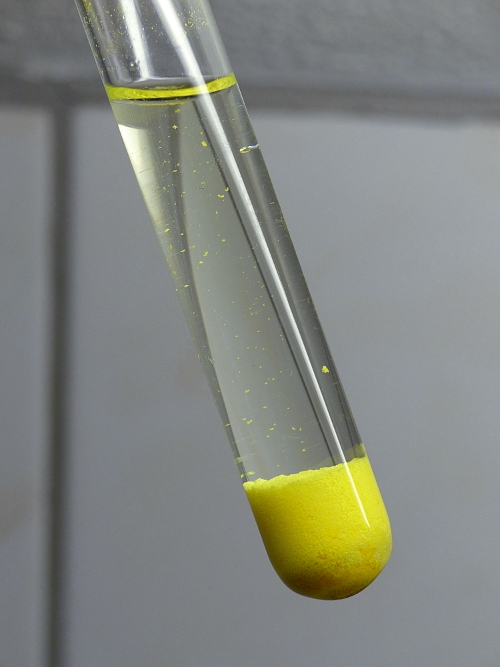
![]() The
yellow precipitate must be rinsed with water to increase its purity and
then it must be filtered. The filtered solid must be kept on the filter
and this filter must be put on a pile of paper tissues. If the filter
is carefully folded and this folded filter is pressed between two piles
of paper tissue, then a fairly dry solid is obtained, which is quite
pure as well. Nearly all water (with impurities dissolved in it) are
absorbed by the tissue paper.
The
yellow precipitate must be rinsed with water to increase its purity and
then it must be filtered. The filtered solid must be kept on the filter
and this filter must be put on a pile of paper tissues. If the filter
is carefully folded and this folded filter is pressed between two piles
of paper tissue, then a fairly dry solid is obtained, which is quite
pure as well. Nearly all water (with impurities dissolved in it) are
absorbed by the tissue paper.
![]() After the above treatment, the solid must be carefully scraped from the
filter and be put in a petri dish or on a watch glass. Then it must be
set aside at a warm dry place for 24 hours or 48 hours (depending on
ambient temperature and humidity of air). It is best to stir the solid
material every few hours and to break apart larger crumbs of material
to assure that the material becomes completely dry.
After the above treatment, the solid must be carefully scraped from the
filter and be put in a petri dish or on a watch glass. Then it must be
set aside at a warm dry place for 24 hours or 48 hours (depending on
ambient temperature and humidity of air). It is best to stir the solid
material every few hours and to break apart larger crumbs of material
to assure that the material becomes completely dry.
After two days, a yellow dry and non-sticky powdered solid is obtained. The material does not look crystalline, it looks like amorphous powder. The final result is shown in the picture below.

This is a small vial with a volume of
2.5 ml or so. The powder is quite fluffy and contains a lot of air.
This amount was not weighed, but it certainly will not be more than 2
grams of solid.
![]()
Some experiment with the yellow
solid
The yellow solid, obtained in this experiment, is quite interesting and allows a few interesting experiments to be done.
Addition
of sodium sulfite
One interesting experiment is to
add a solution of sodium sulfite to the yellow solid. Simply add some
of the solid to a dry test tube and then add a dilute solution of
sodium sulfite. When this is done, then the solid immediately turns
black. The black solid in turn slowly dissolves and finally, a pale
yellow solution is obtained, which has a faint smell of sulphur dioxide.
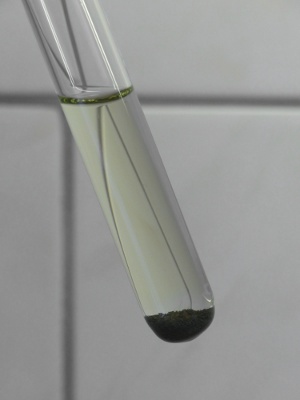
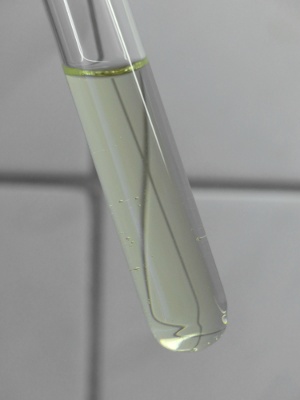
The pale yellow color is due to
the presence of iodide ion in the presence of sulphur dioxide. This
pale yellow color is not due to the presence of free iodine or of
remains of the tetrachloroiodate(III), it is a complex of iodide ion
and sulphur dioxide. For more information, see this
page.
Addition
of sodium hydroxide
Another interesting experiment is adding sodium hydroxide. When this is done, then the result is quite striking. For this experiment, some of the yellow solid must be taken and then a not too strong solution of sodium hydroxide must be added. The solid immediately turns bright orange and it quickly dissolves. It dissolves much faster than in a solution of sodium sulfite of similar concentration. The pictures below show a small amount of the yellow solid, to which a solution of sodium hydroxide is added.

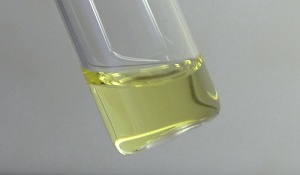
Below follows a better picture of the orange solid. It was prepared by adding dilute sodium hydroxide to a fairly large chunk of wetted powder of tetramethylammonium tetrachloroiodate(III) and avoiding shaking or swirling of the test tube:

On shaking, the orange solid falls apart quickly and dissolves, giving a yellow solution.
Addition
of ammonia
No attempt was made to isolate this grey solid or drying it, because of the explosive and very unstable nature of NI3·NH3.
![]()
Discussion of results
![]() Iodic acid reacts with concetrated hydrochloric acid and gives chlorine gas and tetrachloroiodate(III) ion:
Iodic acid reacts with concetrated hydrochloric acid and gives chlorine gas and tetrachloroiodate(III) ion:
HIO3 + 5H+ + 6Cl– → ICl4– + 3H2O + Cl2
The ICl4– is not very stable and easily loses ICl3. In water it is hydrolyzed as follows:
5ICl4– + 9H2O→3IO3– + 18H+ + I2 + 20Cl–
Adding a salt of tetrachloroiodate(III) to water results in formation of a brown solution of iodine and it even is possible that some solid iodine settles from the aqueous solution. Only at high concentrations of chloride and acid (i.e. in concentrated hydrochloric acid) this hydrolysis reaction does not occur.
![]() The tetrachloroiodate(III)
forms fairly stable salts with large cations. The potassium salt can be
isolated, but in contact with air it quickly loses ICl3. The rubidium and cesium salts already are somewhat more stable, but still, these also easily lose ICl3
and quickly hydrolyse in aqueous solution. With the tetramethylammonium
ion, however, a salt is produced, which binds the
tetrachloroiodate(III) ion more strongly, because of its low
solubility. In contact with air, the solid only has a very faint smell,
while solid RbICl4 or KICl4 has a very strong choking smell of iodine
trichloride.
The tetrachloroiodate(III)
forms fairly stable salts with large cations. The potassium salt can be
isolated, but in contact with air it quickly loses ICl3. The rubidium and cesium salts already are somewhat more stable, but still, these also easily lose ICl3
and quickly hydrolyse in aqueous solution. With the tetramethylammonium
ion, however, a salt is produced, which binds the
tetrachloroiodate(III) ion more strongly, because of its low
solubility. In contact with air, the solid only has a very faint smell,
while solid RbICl4 or KICl4 has a very strong choking smell of iodine
trichloride.
The yellow solid, produced and isolated in this experiment is N(CH3)4 ICl4.
![]() When the tetrachloroiodate(III) ion comes in contact with sulfite, then
it immediately is reduced to iodine and chloride ions. When there is
excess sulfite, then the iodine in turn is reduced to iodide ions.
When the tetrachloroiodate(III) ion comes in contact with sulfite, then
it immediately is reduced to iodine and chloride ions. When there is
excess sulfite, then the iodine in turn is reduced to iodide ions.
2ICl4– + 3SO32– + 3H2O→I2 + 3SO42– + 6H+ + 8Cl–
This explains the change of color from yellow to dark grey as soon as the sulfite is added to the yellow solid. The reaction is very fast, it is nearly instantaneous. If excess sulfite is present, then the iodine also is reduced, but this reaction takes more time:
I2 + SO32– + H2O→2I– + SO42– + 2H+
Both the reduction of
tetrachloroiodate(III) and the reduction of iodine produce acid and
this in turn reacts with excess sulfite ions to water and sulphur
dioxide. This explains the smell of sulphur dioxide in the experiment
and it also explains the weak yellow color of the final solution, due
to formation of the yellow complex I·nSO2– (see this
page).
![]() The reaction with sodium hydroxide is not really clear to me. The final
reaction can be explained, but the intermediate orange solid is unknown
to me. Maybe it is due to formation of iodide, which forms a red-brown
complex with iodine, which is trapped in the solid, but this is not
tested by experiment.
The reaction with sodium hydroxide is not really clear to me. The final
reaction can be explained, but the intermediate orange solid is unknown
to me. Maybe it is due to formation of iodide, which forms a red-brown
complex with iodine, which is trapped in the solid, but this is not
tested by experiment.
The final reaction is hydrolysis
as described above, where the acid is neutralized by the hydroxide ions
and the iodine reacts to hypoiodite and iodide.
![]() The
reaction with ammonia is easy to explain. The reaction again is
hydrolysis with formation of iodine and this iodine in turn reacts with
ammonia in the well-known reaction in which so-called "nitrogen
triiodide" is formed, which in reality is a combination of NI3 and NH3.
The
reaction with ammonia is easy to explain. The reaction again is
hydrolysis with formation of iodine and this iodine in turn reacts with
ammonia in the well-known reaction in which so-called "nitrogen
triiodide" is formed, which in reality is a combination of NI3 and NH3.